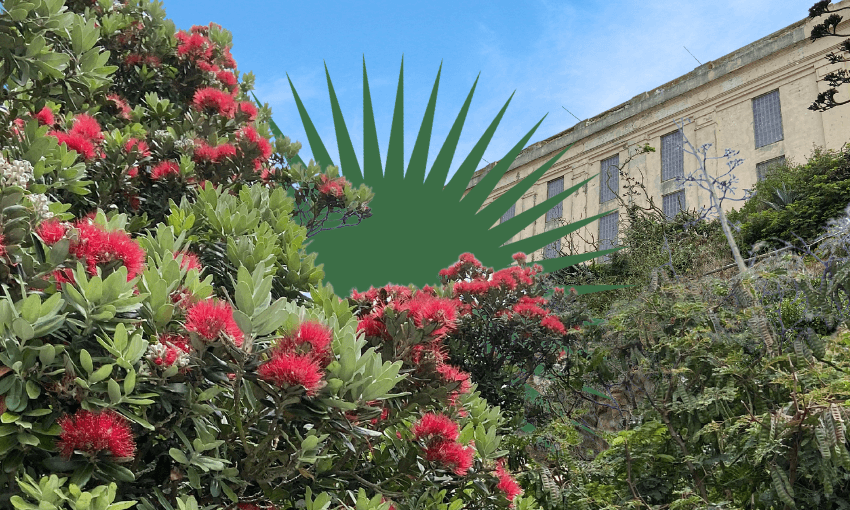A recent visit to San Francisco brought an unexpected discovery for Stewart Sowman-Lund. He goes in search of answers.
Walk around the coast of San Francisco and you could forgive yourself for thinking you were in Wellington during summer. Narrow, winding roads, a constant view of the sea, a chilly breeze – and streets lined with flowering pōhutukawa.
Perhaps I was alone in that I’d never contemplated New Zealand has to share the pōhutukawa, our unofficial Christmas tree, with anywhere else. But a recent trip to the US city quickly taught me otherwise. It was on a day trip to Alcatraz Island where I made my first discovery. Turning a corner on a winding seaside path in front of the deserted prison that once held some of America’s most notorious inmates, I passed under the boughs of two fully grown pōhutukawa. They were perched on the edge of a cliff face with sweeping views across the city and the fog-covered Golden Gate Bridge. How, and more importantly, when had these trees made it all the way to an island in the middle of the ocean 10,000 kilometres away from Aotearoa?
Shelagh Fritz, from the Golden Gate National Parks Conservancy, told me the pair of pōhutukawa on Alcatraz are close to 100 years old. They are believed to have been planted in the mid to late 1930s, she explained, which would mean they arrived on the island just as notorious gangster Al Capone – or Scarface – was being locked behind bars there. The trees were planted by Freddie Reichel, the first secretary to Alcatraz’s warden and someone who took an interest in developing the prison’s gardens. “Reichel consulted horticulturists of the time for recommendations on what to plant that would survive the tough seaside conditions, and these trees were recommended to him,” Fritz said.
As this blog post explains, the gardens of Alcatraz had been tended to by military inmates dating back to the 1860s. But by the 1930s, when the famously escape-proof prison was housing gangsters, it was the maximum-security prisoners involved in keeping the gardens thriving. Though it’s impossible to know for sure, and it’s quite a strange image to evoke, that could mean that the likes of Capone and Machine Gun Kelly (not the musician) helped to nurture the trees that are still standing nine decades later. While we can’t be certain who planted them, this report from the Washington Post confirms that the pōhutukawa were “prisoner-planted” trees. That means they survived the decades after the prison closed, when the island was abandoned, and before it was taken over by the National Park Service in the early 2000s.
The two pōhutukawa on Alcatraz could feasibly be the oldest in San Francisco, but they are far from the only flourishing Metrosideros excelsa in California. A planting spree in the 1980s means there are well over 4,000 of the trees dotted around coastal parts of the city. On Reddit, someone even asked last year about two “anemic looking” pōhutukawa “hanging out in the middle of the road near Hermosa Beach” in Los Angeles. But, as the New York Times reported over a decade ago, they’re a lot less popular in the United States than they are here – the article describes the trees as a “cursed relic” from a decade that had a lot of “ill-fated ideas”. That’s because the pōhutukawa’s ability to withstand rapidly changing weather conditions is in part thanks their thick roots which have led to warped sidewalks and damaged underground sewers. One San Francisco woman, who had a pōhutukawa planted outside her house in 1984, found that by 2010 it had caused the footpath to buckle and because of a local law, the council had tried to make her cover the bill.
This article from 2011 provides advice to locals on how to prune “New Zealand Christmas trees” in order to stop the roots from growing even more. Needless to say, pōhutukawa are no longer being planted in San Francisco, though you’ll still spot dozens of them decorating front lawns and street corners (you can be penalised close to $2,000 if you try to remove one without permission). There are even other varieties of the tree there, including one with a yellow flower that started as a mutation in Hawke’s Bay and was brought to California in the 1960s.
Thankfully, the two pōhutukawa growing on Alcatraz don’t seem likely to upset anyone. “They are thriving and are a perfect fit for life on the island,” said Fritz. A small part of New Zealand on display in the most unexpected of locations.



